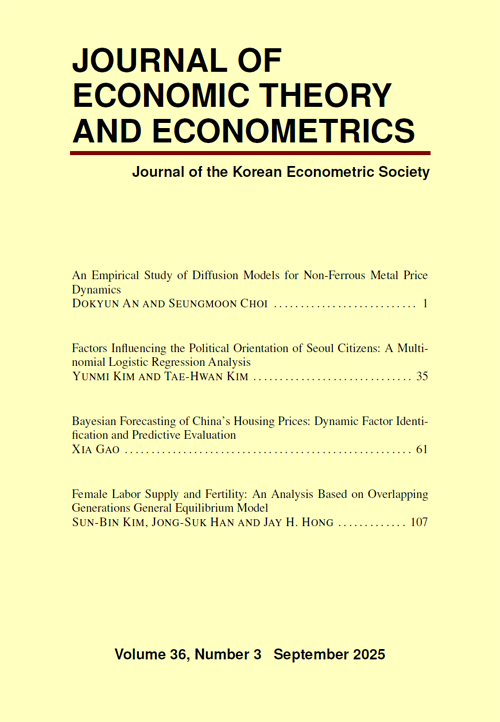- 영문명
- Female Labor Supply and Fertility: An Analysis Based on Overlapping Generations General Equilibrium Model
- 발행기관
- 한국계량경제학회
- 저자명
- 김선빈(Sun-Bin Kim) 한종석(Jong-Suk Han) 홍재화(Jay H. Hong)
- 간행물 정보
- 『JOURNAL OF ECONOMIC THEORY AND ECONOMETRICS』Vol.36 No.3, 107~139쪽, 전체 33쪽
- 주제분류
- 경제경영 > 경제학
- 파일형태
- 발행일자
- 2025.09.30

국문 초록
우리나라의 합계출산율은 1980년대 초반부터 지속적으로 하락하여 최근에는 0.7명대를 기록하여 OECD 국가들 중에서 가장 낮은 수준이다. 본 연구에서는 기혼 여성들의 노동공급과 출산 및 육아에 관한 의사결정 과정을 반영될 수 있는 중첩세대 일반균형 모형을 구축하고 여성들의 노동시장에서 여건의 개선, 특히 성별 임금격차의 축소가 기혼 여성의 노동공급과 출산에 대한 의사결정에 미친 영향을 분석하고자 한다. 2015년부터 2019년까지의 평균을 기준경제로 설정하여 해당 시기에 기혼 여성들의 고용률과 자녀 출산수 등을 잘 설명할 수 있도록 모형경제의 모수들을 설정한다. 기준경제에서 여성들의 출산 의사결정은 해당 시기 우리나라의 가구 특성에 따른 연령별 평균 자녀수와 가계의 소득분위별 평균 자녀수 등을 잘 설명할 수 있다. 1990년대의 성별 임금격차를 반영하도록 모수들을 재설정한 경제에서는 여성의 노동공급에 대한 인센티브가 현저하게 낮아지므로 기혼 여성들이 노동공급 보다는 출산율을 높이는 경향이 정량적으로 확인된다. 다만 정량적인 합계출산율의 변화가 충분히 크지 않아서 성별 임금격차 한가지 요인만으로는 과거 30년간 나타난 여성의 고용률 상승과 합계출산율 저하를 충분히 설명하지는 못한다.
영문 초록
Since the early 1980s, South Korea’s total fertility rate (TFR) has continuously declined, recently reaching the 0.7 range—the lowest among OECD countries. This study develops an overlapping generations (OLG) general equilibrium model that incorporates married women’s labor supply decisions as well as their choices regarding fertility and childrearing. The model is calibrated to match average labor force participation rates of married women and fertility outcomes over the period 2015-2019. In the baseline economy, women’s fertility decisions replicate the age-specific average number of children and fertility patterns across household income groups observed in the data. When the model parameters are adjusted to reflect the gender wage gap observed in the 1990s, women’s incentives to participate in the labor market decline substantially, leading married women to increase fertility instead of labor supply. Quantitatively, however, the change in the TFR is not large enough to explain the sharp decline in fertility observed over the past three decades. This suggests that the gender wage gap alone cannot fully account for the simultaneous rise in female employment and fall in fertility in South Korea.
목차
1. 서론
2. 합계출산율과 성별 임금격차의 변화
3. 모형
4. 캘리브레이션
5. 수량분석
6. 결론
참고문헌
키워드
해당간행물 수록 논문
참고문헌
- 경제인문사회연구회
- 한국노동연구원
- 국제경제연구
- 국회예산정책처
- 경제학연구
- 고용동향 브리프
- 공공경제
- 재정학연구
- 복지행정논총
- 노동경제논집
- Demographic and Economic Change in Developed Countries, Universities-National Bureau Conference Series
- Japan Labor Issues
- International Economic Review
- Review of Economic Studies
- IZA Journal of Labor Economics
최근 이용한 논문
교보eBook 첫 방문을 환영 합니다!

신규가입 혜택 지급이 완료 되었습니다.
바로 사용 가능한 교보e캐시 1,000원 (유효기간 7일)
지금 바로 교보eBook의 다양한 콘텐츠를 이용해 보세요!


